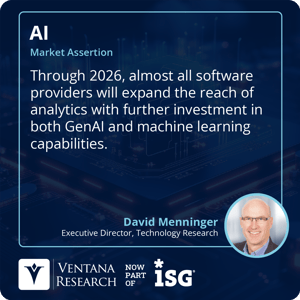Data and analytics have become increasingly important to all aspects of business. The modern data and analytics stack includes many components, which creates challenges for enterprises and software providers alike. As my colleague Matt Aslett points out, a better term might be modern data and analytics smorgasbord. There are arguments for and against using an assortment of tools versus a consolidated platform. For example, purchasing, integrating and deploying a variety of tools can be complex. It can also create an ongoing maintenance burden. On the other hand, a consolidated platform may not be integrated well enough itself and may not be open to use with other components. SAP recently announced a series of enhancements and upcoming capabilities for its SAP Business Technology Platform data and analytics products to help address some of these. In our most recent Analytics and Data Buyers Guide SAP was rated Exemplary and an overall leader. In our Data Operations Buyers Guide, SAP was also rated Exemplary.
Generative AI (GenAI) gets much of the attention these days. Our research shows enterprises plan to allocate about half of their artificial intelligence (AI) budgets to GenAI. We expect software providers to follow suit, and we assert that through 2026, almost all software providers will expand the reach of analytics with further investment in both GenAI and machine learning capabilities. SAP has made significant investments here, introducing Joule as their GenAI assistant or copilot. The Joule copilot capabilities can now be used with SAP Analytics Cloud (SAC) to assist with the creation and development of reports, dashboards and even plans. As I’ve previously pointed out, planning is critical to making informed decisions, and SAP is among only a handful of vendors that integrate planning capabilities with analytic capabilities. Being able to use GenAI in the planning process will make it even easier to create and modify plans, delivering more value from the planning process. The company also announced, for availability later this year, SAP Analytics Cloud compass, which enables Monte Carlo simulations to explore uncertainties and the probability of their impact.
software providers to follow suit, and we assert that through 2026, almost all software providers will expand the reach of analytics with further investment in both GenAI and machine learning capabilities. SAP has made significant investments here, introducing Joule as their GenAI assistant or copilot. The Joule copilot capabilities can now be used with SAP Analytics Cloud (SAC) to assist with the creation and development of reports, dashboards and even plans. As I’ve previously pointed out, planning is critical to making informed decisions, and SAP is among only a handful of vendors that integrate planning capabilities with analytic capabilities. Being able to use GenAI in the planning process will make it even easier to create and modify plans, delivering more value from the planning process. The company also announced, for availability later this year, SAP Analytics Cloud compass, which enables Monte Carlo simulations to explore uncertainties and the probability of their impact.
As enterprises seek to use GenAI, they have learned that retrieval augmented generation (RAG) is important to improve accuracy and, therefore, trust in the responses. Vector search, discussed more fully here, utilizes vector embeddings to perform similarity searches by enabling rapid identification and retrieval of similar or related data that can be provided to the large language models, augmenting the prompts. To support its various GenAI capabilities, SAP HANA Cloud now includes vector database capabilities.
SAP also addressed issues of integration both within its own product line and with third parties. SAP Datasphere, launched last year, is now integrated with SAC, unifying data management capabilities across its data platforms and analytics products. In addition, Collibra’s integration with Datasphere has been expanded to support AI governance, including the data governance for the model inputs, a model catalog and a catalog of model outputs. Datasphere also provides Apache Kafka and Confluent integration, initially enabling outbound streaming of data into these environments, with inbound consumption of streams planned for later this year. These integrations indicate that SAP recognizes the importance of supporting a third-party ecosystem, and there are other integrations in the works.
Another capability in the works is Datasphere knowledge graph, which is currently in private preview. As data is loaded into Datasphere, knowledge graph will automatically create an ontology representing the relationships in the data. Once the ontology is created, it can also be modified and extended with an ontology editor. The knowledge graph will support Joule copilot interactions, making it easier to ask questions and get accurate, documented responses from the data.
These enhancements will certainly benefit existing SAP customers. Datasphere will more easily support SAC implementations. Integrations with other data management products reflect the reality in most enterprises today. Those organizations that are challenged by the data management smorgasbord now have some additional reasons to consider SAP’s offerings. I recommend that organizations evaluating their data management infrastructure, especially existing SAP customers, consider SAP Datasphere and SAP Analytics Cloud.
Regards,
David Menninger


 software providers to follow suit, and we assert that through 2026, almost all software providers will expand the reach of analytics with further investment in both GenAI and machine learning capabilities. SAP has made significant investments here,
software providers to follow suit, and we assert that through 2026, almost all software providers will expand the reach of analytics with further investment in both GenAI and machine learning capabilities. SAP has made significant investments here, 








